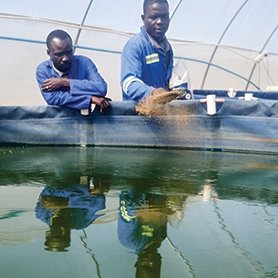Asian seabass (Lates calcarifer) is a commercial species highly appreciated in the Asian seafood markets and has been cultured in Singapore for the past four decades. Big belly disease (BBD) is one of the major diseases in Asian seabass hatcheries. It occurs typically in 25-60 day-old fry in hatcheries and the mortality rate is 80-99.5% of the population without treatment. It is still unclear which bacteria cause BBD although a recent study reported that a newly described Vibrio species might be the pathogen for this disease. Therefore, breeding programs to improve BBD survival/resistance might be one of the approaches for improved survival and resistance.
In 2004, to improve growth, meat quality, and disease resistance, a selective breeding program started in Singapore for Asian seabass with 45 mass-crosses with 549 F0 fish – 165 from Malaysia, 148 from Indonesia, and 132 from Thailand.
In 2009, 600 elite F1 fish, selected from over 13,500 F1 fish, were genotyped with 10 microsatellites and three groups of brooders were established, each with 120–130 brooders, to produce F2 for further selection. In each group, at least six separate mass-crosses based on 20 males and 20 females were set up to produce offspring for further selection.
To know the contribution of brooders to offspring, F2 larvae at the age of 1–3 DPH were collected, and their DNA was extracted. All the collected offspring were genotyped and the largest individuals (up to 192 per batch) were tagged.
In 2012, two outbreaks of BBD occurred during the project and only 437 of the 6,000 F2 Asian seabass juveniles survived. Taking the opportunity presented by these outbreaks, researchers from the National University of Singapore conducted a selection of F1 and F2 fish for high BBD survival using the recorded genotypes.
Molecular parentage analysis with 10 microsatellites revealed that four parents (F1) produced a high percentage of offspring that survived the BBD outbreaks and were selected as high BBD-survival F1 brooders in 2012. Eighty-two BBD survivor offspring (F2) were selected based on their growth performance at 90 DPH, family origin, and allelic diversity and were used as brooders to generate F3.
In a period of five years, these F2 brooders produced six batches of offspring, where no outbreak of BBD occurred. In the same period, outbreaks of BBD occurred in four batches produced by F2 brooders selected for growth, with mortality rates ranging from 85.1-95.4%.
In F3, the average body weight of the line for BBD survival was slightly lower (57.1 ± 1.09 g) than that of the line for growth at 90 DPH (60.6 ± 2.29 g). In both lines, the body weight of F3 was much higher than that of F2.
These results indicate that the selection of BBD survival during BBD outbreaks using molecular parentage analysis is effective to reduce BBD outbreaks. However, the genetic diversity in the F3 line for BBD survival was much lower than that in the F3 line for growth due to the small founder population as well as the growth performance.
Therefore, to avoid further reduction of genetic diversity, which is essential in the line selected for increased survival against BBD, “further breeding of the BBD survival line should be performed using novel technologies (genomic selection and genome editing) or increasing genetic variation by introducing new BBD-resistant/survival brooders,” researcher said.
Reference:
Liu, P., Xia, J. H., Sun, F., Wang, L., Yang, Z., Lee, M., Pang, H. Y., Wen, Y. F., & Yue, G. H. (2022). Breeding Asian seabass to increase survival against big belly disease and growth. Aquaculture and Fisheries. https://www.sciencedirect.com/science/article/pii/S2468550X22001356













